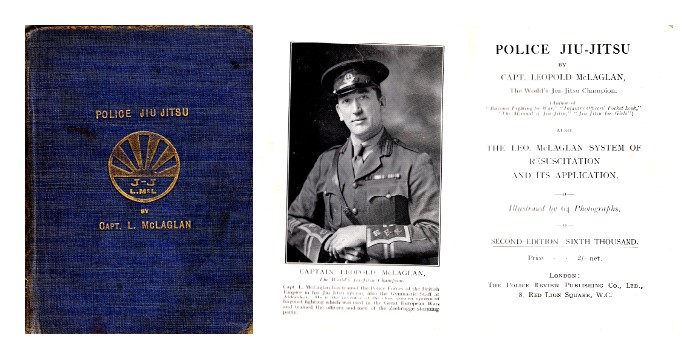Early 20th century policing can conjure up many images: a bobby on the beat with his whistle, truncheon, and a familiar but stern “Ello, ello, ello”. But an image we might not usually associate with interwar policing is Jiu Jitsu. August’s Object of the Month features an instructional police manual on the martial art, titled “Police Jiu Jitsu” by Captain Leopold McLaglan.
Captain McLaglan styles himself as “The World’s Jiu-Jitsu Champion” and has a long list of credits teaching police forces from around the world in the martial art, from Australia to Africa. He also trained British troops during World War I in close combat techniques, most notably the storming parties and officers who assaulted Zeebrugge in Belgium.
The introduction to the manual describes McLaglan’s philosophy of technique and skills over brute strength and demonstrates his knowledge of the human anatomy. He speaks of the history of Jiu-Jitsu originating in ancient Japan, and being used to overcome better armed and armoured opponents.
The manual itself is full of fascinating images, showing a well-dressed police constable in various stages of combat with an equally well-dressed assailant. Many of the techniques are what you might expect, positions of arm locks and other ways to restrain an attacker, but some are quite extreme, such as disarming a gun wielding criminal and the descriptively named “Nose Throw”. The techniques given are very practical, with no mention of the philosophy and spiritualism we associate with modern martial arts today. Instead, the manual gives stoic advice on Adam’s apple strikes and how to break an opponent’s wrist.
The manual is not all violence however, and the end section has several pages on resuscitation and recovery using the same knowledge of anatomy. Again, these instructions seem practical, and although they do not comply with modern first aid techniques, they do employ accurate principals.
This brief look into an unexpected part of the 1920s police officer arsenal ends with commendations from police captains across the world, showing that at the time clearly a lot of stock was placed in McLaglan’s ideas and training. McLaglan was not only famous for teaching Jiu-Jitsu, but also for various other martial arts, his acting career, and several scandals in New Zealand where he something of a celebrity.
This blog post was written by one of our curatorial volunteers. The manual is currently not on display but kept in our museum stores.
 Prison & Police Museum
Prison & Police Museum